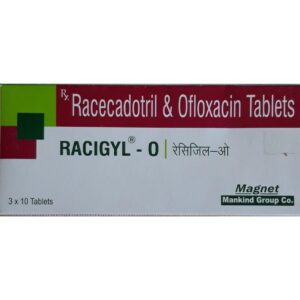OFLOXACIN + RACECADOTRIL
Ofloxacin: Ofloxacin is a fluoroquinolone antibiotic that is used to treat various bacterial infections. It is commonly prescribed for infections of the urinary tract, respiratory tract, skin, and soft tissues.
The mechanism of action of Ofloxacin involves inhibiting bacterial DNA synthesis by targeting two essential enzymes, DNA gyrase and topoisomerase IV. This prevents the separation of bacterial DNA strands, inhibiting replication and ultimately leading to bacterial cell death.
The recommended dose of Ofloxacin can vary depending on the type and severity of the infection. Typical doses range from 200-800 mg per day, divided into two doses. It is important to follow the exact dosage instructions provided by the prescribing healthcare professional.
Like most medications, Ofloxacin may cause side effects. Common side effects include diarrhea, nausea, vomiting, abdominal pain, headache, dizziness, and insomnia. Other less common side effects may include skin rash, itching, and photosensitivity (increased sensitivity to sunlight). In rare cases, Ofloxacin may cause serious side effects such as tendon rupture, nerve damage, or allergic reactions. It is advisable to seek immediate medical attention if any severe or persistent side effects occur.
As with any medication, it is crucial to inform the prescribing healthcare professional about any pre-existing medical conditions or ongoing medications to avoid potential drug interactions or contraindications.
Racecadotril: Racecadotril is a medication that is primarily used as an anti-diarrheal agent. It is commonly prescribed for the treatment of acute diarrhea in both children and adults.
The mechanism of action of Racecadotril is unique compared to other anti-diarrheal medications. It works by inhibiting the enzyme enkephalinase, which is responsible for the breakdown of endogenous enkephalins in the intestines. By inhibiting enkephalinase, Racecadotril increases the levels of enkephalins, which are natural opioids, in the intestines. These enkephalins then reduce the secretion of water and electrolytes into the intestines, which helps to decrease the severity and duration of diarrhea.
The usual recommended dose of Racecadotril for adults is 100 mg, taken three times a day, for a maximum duration of seven days. For children, the dosage is based on their body weight and is typically around 1.5 to 2 mg per kg of body weight, divided into three doses per day. It is important to follow the dosage instructions provided by your healthcare provider.
Like any medication, Racecadotril can have side effects. The most commonly reported side effects include abdominal pain, nausea, vomiting, and constipation. These side effects are generally mild and temporary. Rarely, hypersensitivity reactions can occur, which may require immediate medical attention. It is important to talk to your doctor about any potential side effects and to report any unusual or severe symptoms.
In conclusion, Racecadotril is an anti-diarrheal medication that works by inhibiting enkephalinase, resulting in a decrease in fluid secretion in the intestines. It is commonly used to treat acute diarrhea in both children and adults. While generally well-tolerated, it can cause mild side effects such as abdominal pain and constipation.

